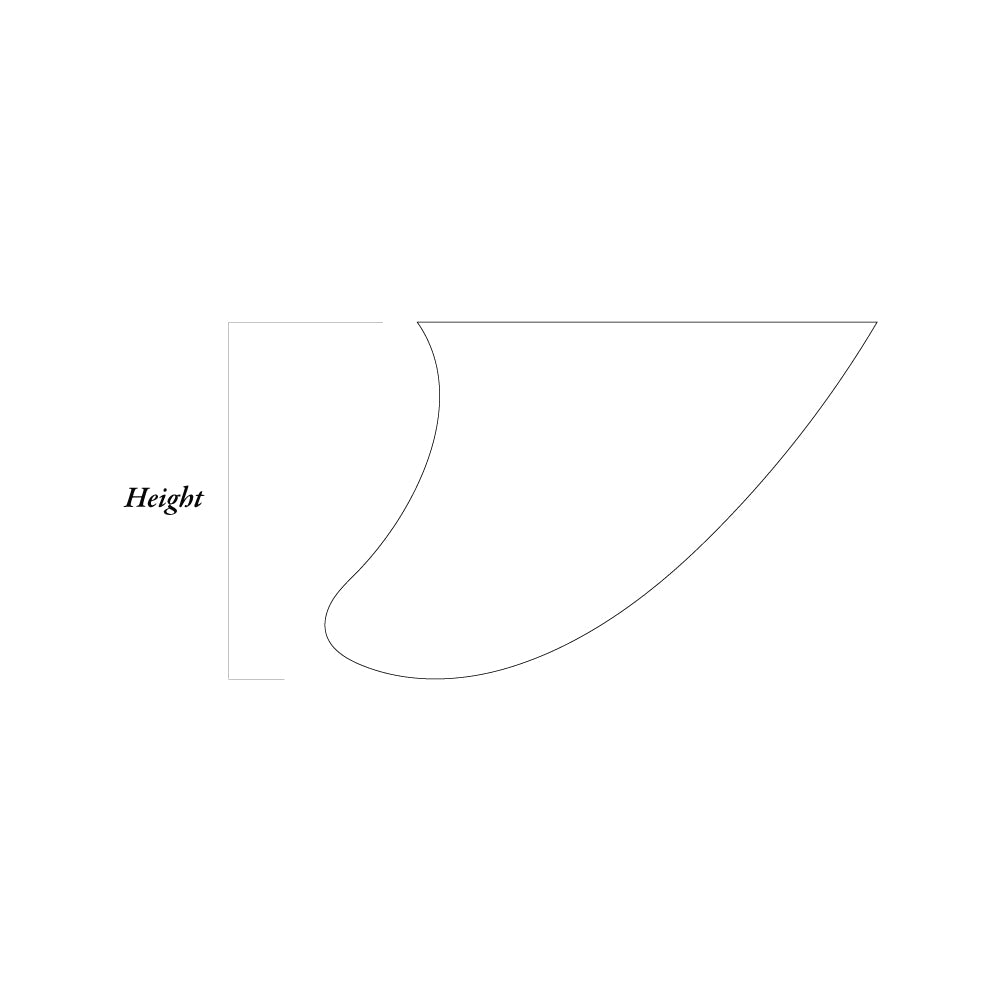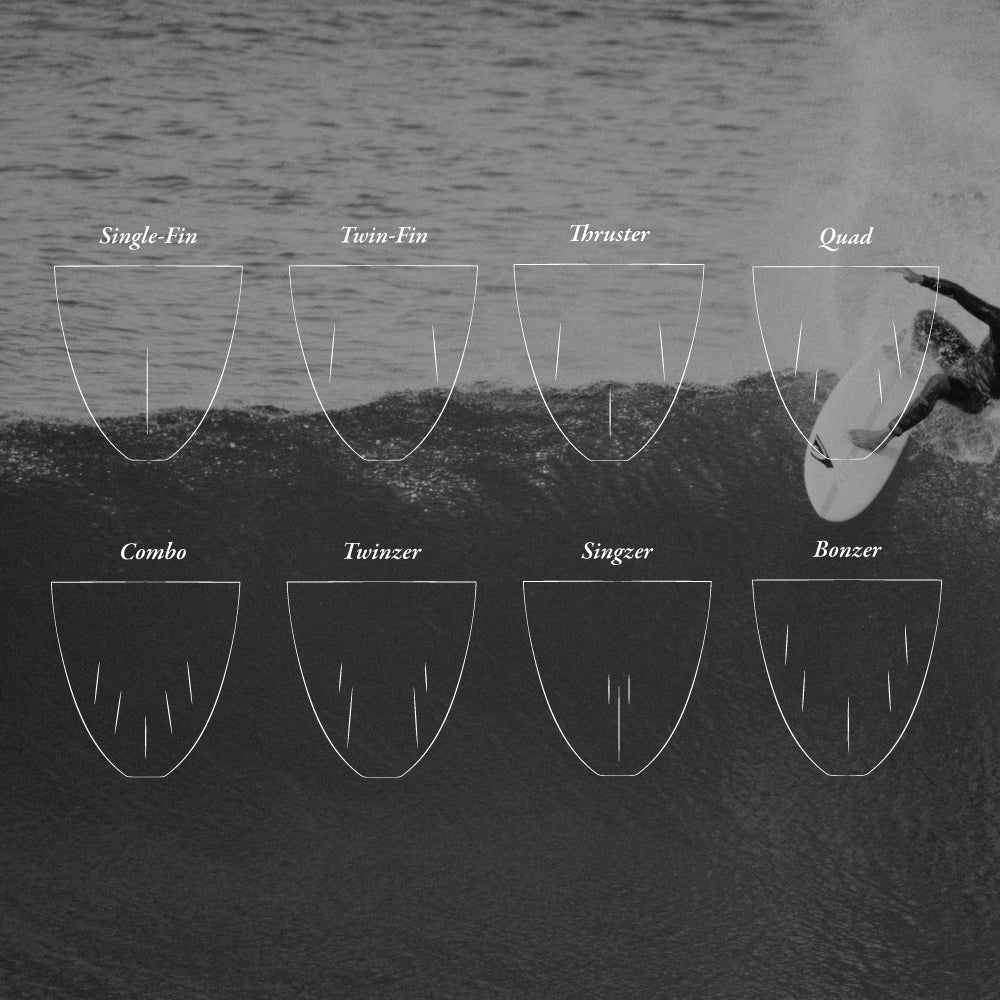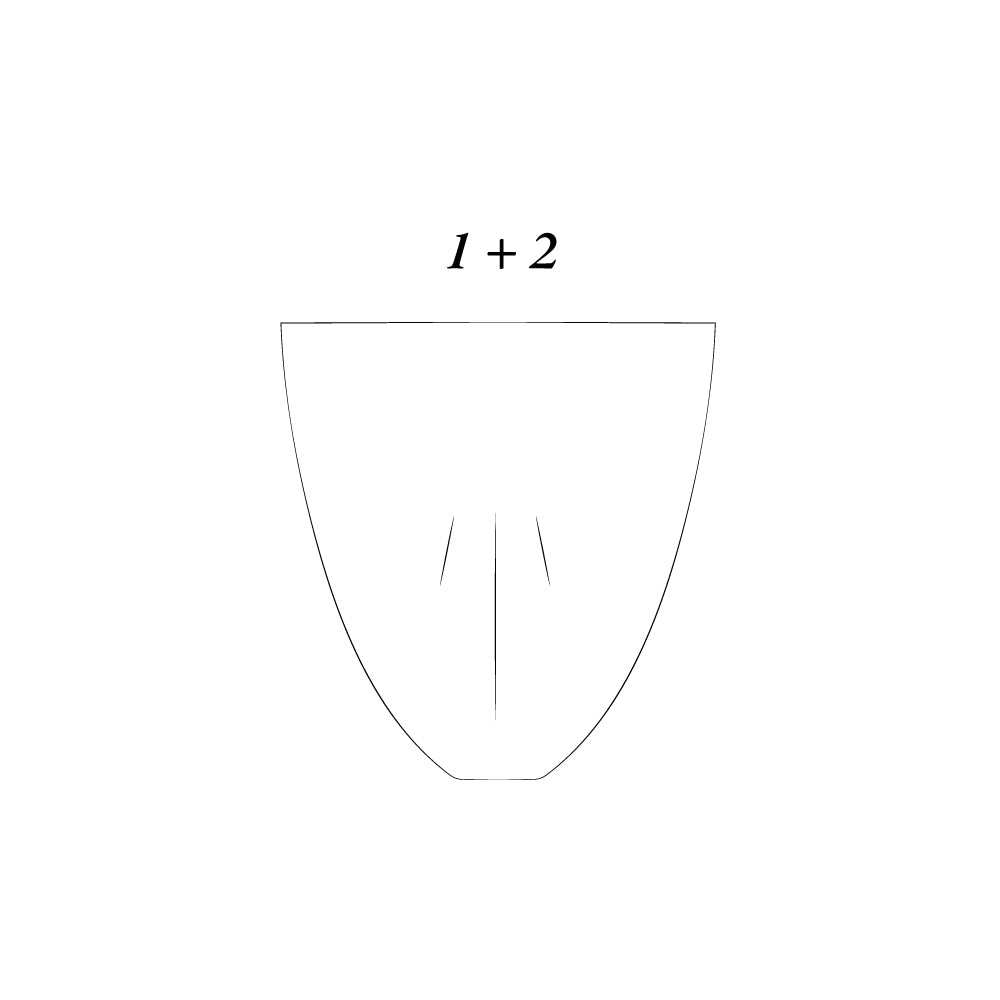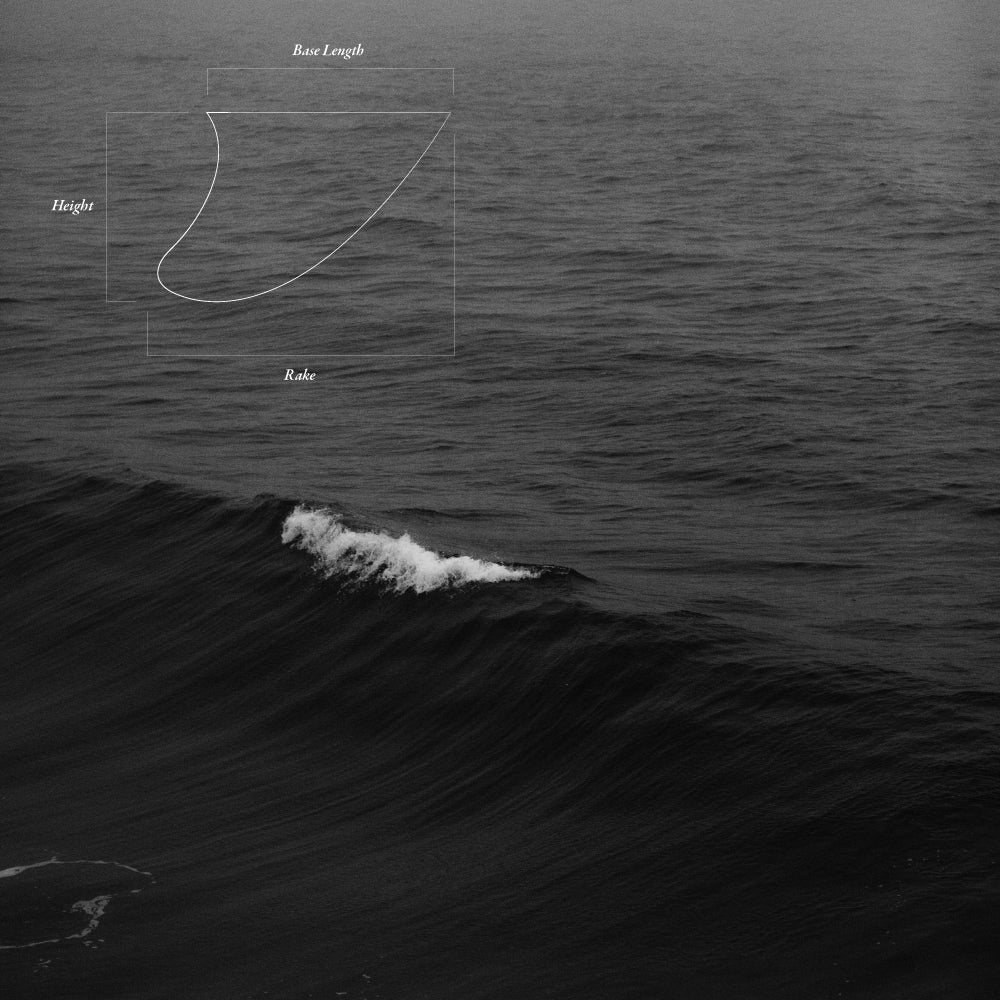Offer
Provide additional details about the offer you're running.
Provide additional details about the offer you're running.
Provide additional details about the offer you're running.

Surfboard fins, where do we begin? Because, let’s be honest, surfboard fins can get a bit (or a hell of a lot), confusing. No matter if you go to your local store or if you visit an online store, the scenario is mostly the same: huge, bright multicolored amount of fins that come in different shapes, sizes and brands, all of them greeting you saying “pick me!.”
By the time you finish reading this post, you will be able to navigate the minefield that fins represent and find your nirvana: understanding what a fin is, how to choose the right one for you and a bit more.
Should we start? Sit down, buckle up and keep reading.
Point number one, fins are too important of a matter for your surfing experience, so let’s start getting to know them a bit better, shall we? Point number two, choosing the best fit for you is not only a matter of the type of board you ride, but it is a matter of your weight, surfing abilities and everything in between as well.
Main Function | What is the main function of a fin? In two words: control & direction. The fins will really affect the way you surf a wave and that’s because their main function is to allow you to convert speed generated by falling (gravitational), into horizontal and upward speed enabling you to drive the board where you want to go on a wave. Meaning, fins will give you control and allow you to pivot and change direction.
Picture a board with no fins: without them it would be difficult to stay ahead of the breaking part of the wave, right?
Talking about types of materials, we are going to cut the conversation short and make it ease for you: surfboard fins are usually either fiberglass, plastic or carbon fibre.
“The size that you make the fin and where you place it will dictate how much you can go up the face and down the line.“ Steve Lis, Sunset Cliffs kneeboarder and shaper.
Now, how you move/surf on a wave and how the fins allow you to, is another story and it has to do with the type of fin set-up; the shape, size and construction; and let’s not forget, the type of waves you are about to surf and your ability to do so.

Tristan Mausse holding Fantastic Acid special fins in Anglet, France.
Fins play a central role on how a board will perform and their anatomy is key to what your surfing experience will be: size, shape, contour, foil’s thickness … How the surfboard feels, can completely change depending on the fins you choose to ride it with.
You may be thinking that there’s no need to know the elements of a fin in a techy way but, we are telling you, it is quite interesting and can come handy as well. So let’s get to know them a bit better to make the best and most efficient choice when getting them.
The gravity force pushing you straight toward the beach gets greater as the wave gets steeper. That is why more fin is needed to resist movement in this direction, so the lift force created on the fin as the boards slides sideways stops the board from sliding too far. This is how a fin should behave, if it works properly.
“Virtually every surfboard in the world has a fish shaped template fin. The high aspect ratio with narrow chord helps maintain laminar flow maximizing lift and tip flex to eliminate tip vortex.” Bob McTavish, Board Designer.

|
Height | A fin’s height is measured from the base to the tip. You’ll have more control and stability the larger the height of the fin, so this is a good fit for you if you are a beginner or a less experienced surfer. For increased maneuverability and ‘radical’ turns, a shorter fin would be advised. When you start checking fins, you will see that they come is different sizes: extra small [XS], small [S], Medium [M], large [L], extra large [XL]. We’ll get to that later but, with this information and your size, you have the basics for choosing a fin quite covered. |
 |
Base Length | The length of a fin is at its base. Longer base translates into more speed and predictability. Shorter base, allows for increased maneuverability instead, so you’ll be able to perform sharper and tighter turns. |

|
Rake | Length of the front edge of the fin, meaning how far back the fin curves from the base to tip. Want speed and predictability? Go for a small rake fin. If you like short, fast tight turns, go for a larger rake instead. |
|
Foil | The foil is the shape of the fin and it is crucial. It affects how well the drag force works and, ultimately, how your board will perform. In other words, the foil refers to the surface of the inside and outside of a fin. The foil changes the flow of the water through and this laminar flow is the one holding the fin in position as it creates a consistent, steady force created by streamlines.
Turbulent flow will do a poor job resulting in loss of hold or side slip because of a variable pressure and drag. |
 |
Efficient Fin Foil | Usually you will find that fins have slightly different foils. A thruster has a symmetrical middle fin with the side fins being a bit rounded on the outside (asymmetrical fins). These asymmetrical fins, that we find as side fins in the thruster or twin fin boards, create a hold improving force. The longer curved surface on one side of the fin, creates a water pressure difference which results in an horizontal force acting toward the curved side of the fin, improving holding power against gravity. |

|
Flex | Indicates how bending the fin is whilst performing turns. A looser turn will be reflection of a fin with great flex, offering lots of fun and unpredictable surfing style. Speed, stability and predictability will be provided by a more inflexible fin. |
“Basically for thrusters you point them more at the nose then the board’ll turn sharper and it won’t run as free down the line. Straighten them up, it will run nicely down the line, but if your board’s got a flat rocker then you might find it hard to do tight turns. So you’re kind of always looking for a nice balance.” Simon Anderson, inventor of the thruster, great surfer of the 70s and early 80s, and a talented designer and shaper.
How the fins are placed, where on the board, the angle they draw in relation to the stringer or to the bottom, whether they are splayed in or out ... All details have they role and we'll see some of them now.
|
Splay or Fin Toe | This feature only refers to the outer fins of a surfboard. It is the angle of the fin (how they stick out), compared to the surfboard’s stringer. The surfboard fins toe is usually different from board to board and they usually are toe-in, meaning that the side fins are in towards the stringer with smaller angle. In other words, fins are splayed typically out looking for more ‘responsiveness’ that increased water pressure along the outside fins provides. This comes very handy for performance surfing. A zero toe-in will mean negligible area pushing water; less drag. |

|
Fin Cant or Camber | It refers to the angle the fin makes in relation to the deck of the board when you look down the stringer (towards bottom of the surfboard). The more cambered a fin is toward the deck, the looser the board will be in yaw or weaving turns. And, let’s also have in mind that the bigger the difference between the angle and the bank or roll angle, the less hold you will be able to rely on in your turn. |
One thing that is critical about fins is where they’re placed on the board. Depending on how forward or back they are, even how close together they are placed in case of multi-fin set-up.
You want fins close to the rail or tail for the most reliable engagement and holding power; that way you don’t need to bury too much of either the rail or tail to have them fully engaged.
 The Surfer Ian Crane setting up its Pukas Hyperlink Thruster Surfboard shaped by Mayhem.
The Surfer Ian Crane setting up its Pukas Hyperlink Thruster Surfboard shaped by Mayhem.
Another important variable that will impact the board’s performance is the way the fins (and how many), are set up on the tail. And believe us when we say that there are multiple combinations of fin set up that you can try. Why? Because each combinations will give you a different feeling once your are on your board.

|
 |

|
1FIN | The single fin is the most traditional fin set up that you can find on beginner boards, longboards and mid lengths. On one hand, it offers control, stability and predictability, so it is perfect to enjoy fast straight line ride. On the other hand, it is difficult and slow to turn; it is limited that way. |

|
2FIN | The twin fin set-up, toed in and tipped out. Today, the twin fin set up is being used by intermediate to advanced surfers with nice, big and strong waves. As the design of surfboards get refined, so does the new surfing styles that demand today’s surfers. Funny enough, this set up originally built for speed and pigeon-holed like difficult for turns and good for crappy, weak and smaller waves, has changed its narrative when it has become one of the most popular fin sets among surfers with mid-lengths twins and fishes. Two fins will provide a round, open, flowing surfing style. If you compare it with a thruster or a quad set-up, the twin fin will feel quicker on that flowing style. |

|
3FIN | Also known as Thruster or Tri Fin set up. Three fins; toed in and canted side fins. The most common fin set-up that you will find nowadays since it was developed by Simon Anderson in 1980. It is a versatile fin set-up for mostly all type of waves. It is the set-up type of choice for performance surfing since it helps you maintain control while speeding on radical maneuvers. Not in vain it paved up the way for aerial surfing. Not only that, it is also one of the set ups that you most commonly find on beginners boards as well. Why? Because it offers a solid control over the board with any kind of wave. |

|
4FIN | The quad or four fin set-up. Again, offers control over your board whilst built up for speed like a twin fin. Enjoy the power and drive through turns with that push of speed; you won’t have to work as hard to generate speed as on a thruster, so it will suit well with different styles of surfing. Quad fin set-up is missing the center fin, the one that provides control and pivot, so the board will feel looser which can be lots of fun in small surf. But what about big, big, big waves? Well, you can also find this set up in gun surfboards. Having an extra fin on each side, it really gives a solid grip when coming done the line. |
 |
5FIN | The combo or five fin set-up, offers speed, grip and stability. This placement of the fins is becoming more and more popular. It offers the ability to swap and change the fin set-up in minutes if your board comes with five fin plugs. Often this set-up gets ridden as a quad using a “trailer fin”, a small central fin. You can even switch to a thruster or a quad depending on how you feel riding in the moment and the conditions of the wave. Guns or step up surfboards are commonly built using this fin set up due to the combination and versatility it offers.
|
 |
2+1 Fin Set Up or Twin + Trailer | This option of adding a little center fin to a twin fin set up adds performance to the board and that little extra solid hold to your board. If you decide to go for a keel fin set for a twin set up, don’t need to add that extra little fin, the trailer; those fins will hold like glue. |

|
1+2 Fin Set Up or Single Fin + Side Bites | This set up is an elaboration on a single fin. These little fins have a clear purpose: to push your single fin into a more of a performance board. This means, a bit more radical surfing and tighter turns. This configuration will retain the smoothness of a single fin, while adding the extra drive and hold that the side bites provide. Combination of different type of single fins and side bites will offer quite a room for experimentation. Enjoy! |

|
Singzer | A single fin accompanied by two bites located forward and next to the box. |

|
Twinzer | The side bites are located a bit forward the twin fin so the rear keeps clear in its original set-up. |

|
Bonzer | This type of fin set up is lesser-know but something to look into surely as a high-performance power surfing with a single fin two pairs of side bites. |
And we are back at the beginning: how not to feel overwhelmed by the ocean of fins that you see before your eyes and that you can choose from. Now that you know a bit more about the basics of surfboard fins, it is time to talk about what to consider when choosing YOUR set of fins.
First thing that we would like you not to forget: a thruster is the best starting point if you are a beginner or if you don’t know where to start. It is the king of fin set-ups even though, as you have been reading, there are many other set-ups that are booming in modern surfing.

Pukas Surfboards with combo fin set up.
Once that idea is clear, next comes your ability and size as the main and more basic elements when selecting your fins:
Ability | This is a no brainer: you need to buy equipment that will fit your abilities or else, it won’t do you any favor when it comes to performing your best. Selecting your fin set is directly related to your ability, how often you get in the water, the type of board or quiver you have, the waves you like to surf, plus how you like to ride them. A single fin may be a better choice for a beginner or someone who likes to longboard, but a thruster with small and flexible fins may be more suitable for an advanced surfer.
Size | Your size, meaning height and weight, is the other key component when choosing your fin set-up. Why? Because it will affect how the board performs and therefore will impact your style.
The bigger the fin, the better for a beginner surfer because it will provide of stability and control. In other words, larger fins will be the best option, the taller and heavier you are.
Here you go a simple and basic fin chart that can help you choose your set doing a first filter by size and weight.
| FIN SIZE | WEIGHT [Kg.] |
| Grom | < 45 |
| Extra Small | < 55 |
| Small | 50-70 |
| Medium | 65-80 |
| Large | 75+ |
| Extra Large | 90+ |
A Matter of ‘Feeling’ | Yes, we know. This is quite a subjective variable, the “feeling”, but actually a good one to considerate when choosing your fins, as well as you do when choosing your surfboard. After having filtered your range of fins by ability, size and weight, then comes how you like your surfing to feel and that, my friend, is something that only you will be able to decide with a bit of time and going in the water, not once, but many times, many times. Practice is your master.

Chris Christenson's Fish Surfboards with glass on fin.
Which ability suits which fin set up? Well is not a perfect science, but there are some abilities that will get a chance to shine better if helped with a proper fin set-up.
| SINGLE FIN | TWIN FIN | THRUSTER | QUAD | COMBO |
|
· Beginner/ Intermediate/Advanced |
· Intermediate/Advanced |
· Beginner · Advanced |Perform radical maneuvers) |
· Advanced | Spice-up their surfing feeling |
· Aim to change their surfer all around |
|
· Stable · Predictable · Safe |
· Maximum speed in small, crappy waves |
· To improve from intermediate level onward |
· Allows speed whilst still having plenty of control |
· Versatile · Fun · Thruster / Twinny / Quad in minutes |
|
· Allows riding with speed in an straight line without much work |
· Loved by advanced surfers when waves are poor |
· Keep things interesting |

|
Glass on Fins | These fins are fixed to the board and can not be removed or adjust. These where the standard as fins where becoming more popular. If you want a good drive and a solid base guarantee, this is it. They may not have the ability to swap, but they’re solid and lighter at the tail than the boards that have a fin box system. Be careful not to damage these fins, because if you do, it will need quite some TLC (Tender Loving Care) to get if fixed: cutting, sanding, fiberglass work… |

|
Single Fin Box | This was the first ever fin box to go into a surfboard, specifically, the one that was called “Hot Curl”. This one was designed and shaped by George Downing from Hawaii, the youngest of a long line of innovative family in the surfing scenario back in the 40s. This box is usually used by single fin boards and 2+1. US Box and Futures are the brands that you will find making this type of fin set up. |

|
Single Tab Fin Boxes | There’s only one rectangular based channel where you’ll fit the surfboard fin. Depending on the box, the fins can be fitted into the board by either hardware or screw less clips and pressure. Futures is surely the most common single-tab fin system.
· Futures System | Born in a garage in California by the Longo brothers in 1996, they are committed to progression. They’re based on Huntington Beach.
The system is slightly different from FCS even though it also uses a single tab tan fits into the box. Once you fit it into the board, you secured with a screw that is tighten by a fin key.
|

|
Dual Tab Fin Boxes | There’s one system here and that is FCS fin set up.
· FCS System | FCS was founded in 1995. More than 25 years ago and with a clear vision: “FCS was born out of the revolutionary idea of creating removable surfboard fins.“ Today is one of the largest surf hardware brands in the world with innovation in their DNA. If you want you can take a look at them here. You can find FCS I, with double tabs attached by screws into the board, and the improved FCS II fin system, where a single tab clips into the board; no screws required. This system also features grub screw holes in order for you to be able to use FCS I fins in these FCS II new boxes. |
|
|
PROS |
CONS |
|
Wide fin variety styles |
It’s rare but fins can get knocked out because no screws hold them in. |
|
|
Easy and fast clip in System |
Needs a bit of strength and technique to put them in. |
|
|
Find it worldwide easily |
Needs of TLC to put them in and out. |
|
|
FUTURES & Captain Fin System (One Tab) |
Fins are securely screwed. |
Needs a bit of time to screw them in the board. |
|
Easy to put them into the board. |
Needs of TLC to remove them. |
Remember, the fins you acquire should fit your surfing skills:
· Large stable fin for beginners.
· Think about the style of surfing you aim to perform if you are an intermediate surfer; a twin fin set up could be perfect to start improving on small waves if you like speed.
· If you aim to perform a more radical surfing, it’s time to start thinking about a thruster as your next move.
As long as you choose the fins that align with your surfing style and size, you can never go too wrong. If you are feeling a bit baffled with all the information that just hit you, breathe, because you made it through the basics! They are not too complicated once you get the hand of it, and we have included some great Pro Tips thanks to 'The Surfboard Book. How to Design Drives Performance' by Sean McCagh.
Fin brands are also putting a great effort at making you better understand the surfboard fin world, so even if the speak their own complicated language at first, listen and learn, they know what they are talking about. And remember, you can always hit us with any questions that may arise on the comments or written us an email [Mikel & Ruth].





